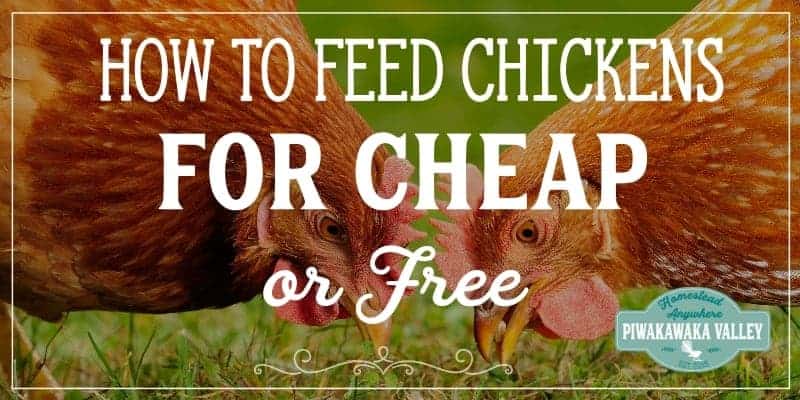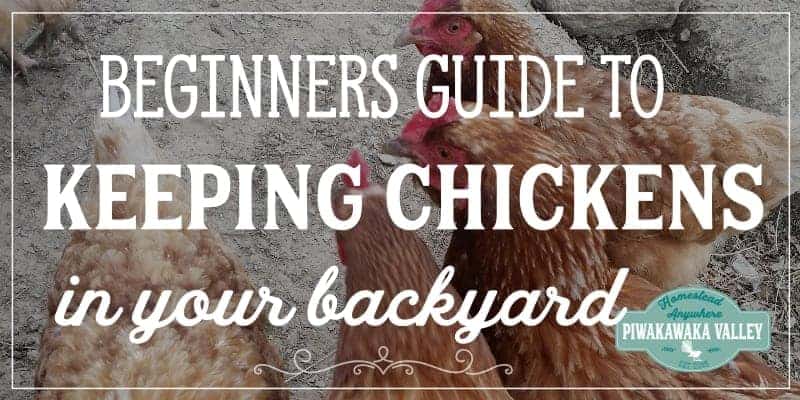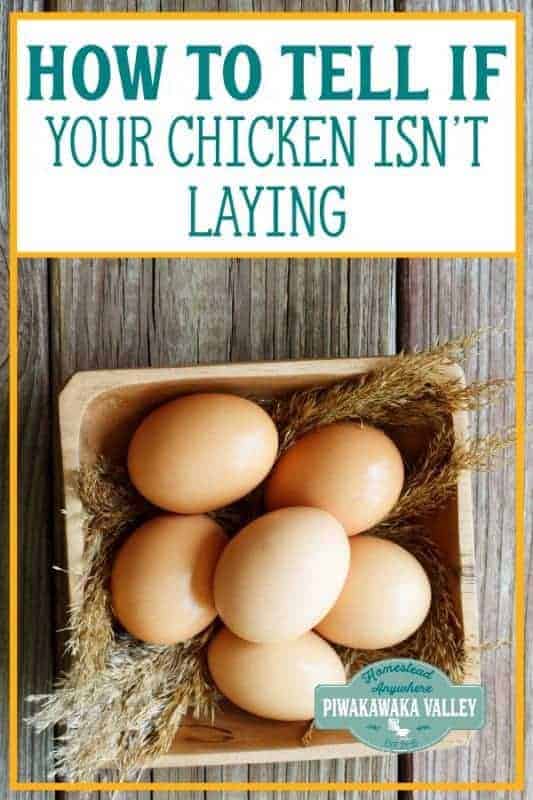This post was most recently updated on November 17th, 2020
If you have been keeping chickens for any amount of time, eventually you will have problems with your chickens stopping laying eggs, or at least a slow down in egg production.
Please read: This information is provided for educational purposes only and is not intended to treat, diagnose or prevent any disease. We encourage you to make your own health care decisions in partnership with a qualified health care professional.
This post contains affiliate links, this means at no extra cost to you, we make a commission from sales. Please read our Disclosure Statement
It can be hard to tell if a hen has stopped laying and there are some transient reasons your chicken egg production may have dropped off, and there are some more long-term reasons.
Some causes of a reduction in egg production are purely seasonal and there is not much you can do about it, and there are causes for a decline in laying rate that are easily remedied.
10 Reasons your chickens may have stopped laying
1. Not enough light
Chickens need a minimum of 14 hours of day light per day to keep up regular egg production. If you live in an area where your light levels dip below this for a portion of the year, then this might be a simple problem to fix.
You can install a simple Solar LED light in the coop set on a timer (optional) to extend the light by a few hours in the evening.
It is usually recommended that you extend the light in the evening as the light suddenly coming on in the morning can frighten the chickens.
RELATED POST: How we cut our chicken feed bill in HALF
2. Moulting
Somewhere between 15 and 18 months of age most chickens will go through a substantial moult.
You can tell if your chickens are moulting as their egg production lowers or stops altogether and they look scruffy and missing feathers.
To help the hens through their moult you can provide extra protein in the form of mealworms, this will speed up their feather regrowing process.
3. Illness or Parasites
Chickens that are suffering from illness or a severe infestation of mites, ticks, fleas or worms will become anemic and deficient in many essential minerals.
As a result their egg production will drop.
You can help treat external parasites with a medicated herbal dust bath.
4. Stress
A stressed chicken is not a laying chicken. If you run a rooster with the flock, he can stress the hens out too if you do not have enough girls in his harem.
If your coop is close to a busy road, dogs or cats or any other way that the chickens may feel threatened, you will not get a full supply of eggs.
If you have ever gotten a wrinkled shell egg, this usually happens when the chicken is stressed or caught while the egg is forming.
RELATED: Easy foods to grow to feed chickens
5. Vitamin deficiency
A deficiency of salt, magnesium, vitamin D or calcium will all result in a chicken that stops laying as frequently.
Another sign that they are lacking in magnesium, calcium or vitamin D is that their egg shells become brittle and eventually they will lay soft eggs.
6. Dehydration
Eggs take a lot of water to produce. If your egg supply starts to suddenly drop off, check that the chickens have access to fresh, clean water.
If they have an autowaterer like this, check that the nipples are actually not blocked.
7. Extremes of temperature
Chickens don’t handle extreme heat or extreme cold well. If you suspect your coop is too hot or too cold, this might be the first place to look to fix the problem.
8. Hiding eggs
Chickens are prey animals. As such they will hide away to lay their eggs. Once they have a large clutch stored somewhere, then they may go broody and go and sit on them.
If you let your chickens out to free range, it might just be that they have found a new favourite place to lay their eggs.
To counter this, you can lock your chickens in their coop for 3-5 days and then only let them out after lunch time after this period of containment.
9. Egg eating
If you are sure that your chickens are in fact laying in their nest box, keep an eye out for signs of the eggs being eaten.
While rats, hedgehogs, ferrets, stoats and weasels will steal eggs, if your coop is secure, it is just as likely that you have an egg eater in your midst.
Look for signs of broken shell, soggy nesting material, egg remains or yolk stuck around the beak of one (or more) of your girls.
Once a chicken has worked out how to break in to an egg, and knows just how delicious they are, it is almost impossible to stop them from eating eggs in the future.
The best cure for a egg eating hen is to cull her before she teaches her tricks to the other hens.
RELATED POST: What to do with egg eating chickens
10. Too old
A time comes in every farm animals existence when it is no longer productive. For hybrid chickens, that is often around 2-3 years of age.
For heritage chickens, they will often keep laying until they are 4 or 5 years old, with decreasing frequency.
It is up to you what you want to do with your chickens that are no longer laying, you could keep them in to old age, retire them to someone else’s place, or cull them.
We choose the latter as nothing lives at our place that doesn’t earn its keep.
5 Ideas on how to get your chickens laying again
There are a few quick things that you can try to get your chickens laying again. If none of these work, then it might be time to rethink what you want to be doing with these chickens!
1. Good quality feed of 16-18% protein
Your girls need to be getting plenty of top quality laying bird feed. If their protein intake over the day is less than 16% then they won’t be laying well.
If your chickens aren’t laying, the first thing you should check is that they are all getting their fair amount of top quality feed each day before going out to top up with free ranging.
RELATED: Everything you need to know about raising laying hens
2. Clean and secure nesting boxes
Make sure that your hens have clean, dark and secure nesting boxes, that are small enough to be cozy but not so small that they are cramped. Usually 1 foot cubes are about perfect.
You need 1 nesting box for every 4 hens plus one spare.
Sprinkle some hay or pine shavings in the bottom of the nesting box to give the eggs somewhere to land.
3. Calcium and Magnesium
Even if you are feeding a balanced feed, sometimes you will need to add some oyster shell grit to their feed to supplement their mineral requirements.
4. Illness or Parasites
Check your ladies over and make sure that they are all looking healthy. If they look like they are battling an infestation of some sort, treat them and then see if their egg production improves.
5. Chilli or Cayenne
An old timey solution to hens that refuse to lay is to add some cayenne or hot peppers to their feed.
This is easily done by using the dried power at a rate of 1 teaspoon to 2 pounds of feed. Do this for 3 days in a row, then every other day until egg production is re-established.
Don’t worry chickens do not have the receptor on their tongue to feel the cayenne like we do. In fact the only taste that chickens can taste is bitter, which protects the chickens from eating toxic plants.
How to tell which of your chickens have stopped laying
If you have worked your way through these causes for a reduction in egg production in your chicken, and you are still coming up short, you can actually asses your chickens to find out which ones have stopped laying.
Comb colour
A chicken that is laying will have a large, fleshy, shiny red comb. He hen that is not laying has a pale pink, shriveled and dry looking comb.
Abdominal softness
Hens that have a belly full of growing eggs have a nice soft abdomen. If you pick up a chicken and her tummy is hard (between her breast bone and her vent) will be hard and firm.
Vent moisture
To push out an egg, the chicken’s vent must be moist, they are also dark pink. If you flip over your chicken and check out her vent and it is dry (or dusty!) and pale, she is no longer laying eggs.
Stature
A chicken that is laying walks tall and with her tail in the air. If your chicken is sulking with her tail pointing to the ground it is usually a sign that she is unwell and not laying.
If you have a chicken that has stopped laying, you have two options – let them live out their natural life or cull them and get fresh, younger stock.
We will always cull a chicken that is no longer laying, as it will be costing us money just to feed it. We sometimes use the chicken to make soup, or keep the meat and frame to use as dog food.
If you like tips on frugal living, self sufficiency and consuming less, sign up to our newsletter below, I would LOVE to have you!







